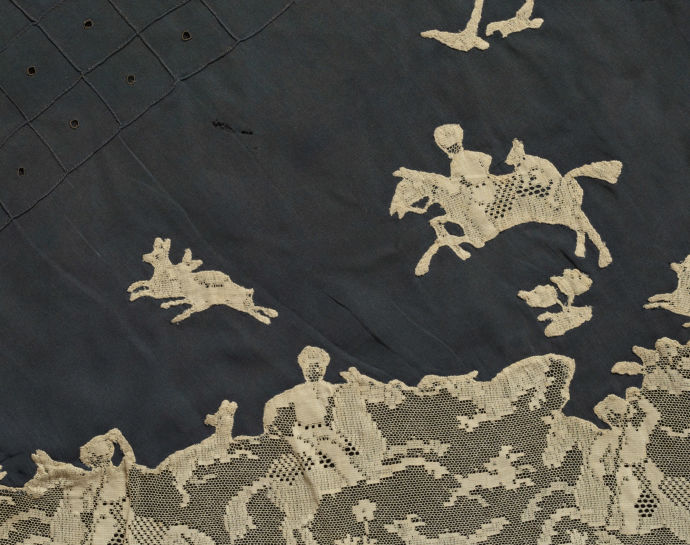It’s Time to Stop Bothering with Underwear,Imaginary Sex With A Woman Who Does Anything and Other News
On the Shelf

A pair of silk-chiffon knickers from the 1930s, on display at the Victoria and Albert Museum.
- Today is Charlotte Brontë’s two-hundredth birthday, and no two-hundredth birthday is complete without a new biography. Claire Harman has furnished one for the occasion, the first new biography in twenty years: Charlotte Brontë: A Fiery Heart. “The main thrust of Harman’s biography,” writes Daphne Merkin, “endeavors to show how this most self-doubting yet obdurate of young women turned her emotional vulnerability and anxieties about her place in society as a fiercely passionate but plain Jane into a new kind of literature, one that forged a candid and poignant female voice of unaccountable power, telling of childhood loneliness and adult longing … There is a wonderfully poignant scene in London when the appearance-conscious Charlotte goes to a fashionable painter for the first of a series of sittings to have her portrait done and is asked to remove ‘a wad of brown merino wool that had stayed on top of her head when she took her bonnet off’—which proves to be a hairpiece. The experience leaves her ‘mortified (to the point of tears).’ ”
- I wear underwear all the time, mainly because my peer group frowns upon diapers. But there are other, deeper reasons, and it’s these that Tom Rachman explores in a trip to a new London exhibition, “Undressed: A Brief History of Underwear”: “The motives for covering up, it turns out, include avoiding chafing, keeping outerwear unsoiled (vital in the days when a person’s outfits were handmade and few), restricting the jiggles of less well-moored body parts, and advertising the sexual organs to better advantage … Women’s wear constitutes the bulk of the exhibition, probably because male undergarments have tended to be staid and uniform, concerned primarily with comfort, in sharp contrast to the female garments concocted to suppress or accentuate the body … The hypocrisy of sexual repression is blatant in historic underwear, which at once prudishly hid the female body while exaggerating its sexual traits: breasts hiked up, hips widened, butt enlarged. A few underwear fads have diminished the sex traits, notably the androgynous looks of the nineteen-twenties and the nineteen-seventies; intriguingly, both were times of comparative sexual liberation.”
- Meanwhile, a traveling show called Famous Deaths lets you experience, in rich multisensory detail, the last four minutes of a famous person’s life. Simply slide on in to a metal mortuary drawer and you, too, can know the smells and sounds of JFK at Dealey Plaza, Whitney Houston in that Beverly Hills tub, Princess Diana in the Pont de l’Alma tunnel. Allison Meier chose the JFK option: “The intense smell of grass and the sound of an approaching crowd filled the small space … I’ve seen the footage, even visited the grassy knoll in Dallas, and some mixture of the saturated 1960s video and the Texas streets merged in my mind with the scents and sounds. I picked out the strong smell of coffee, which [cocreator Marcel] van Brakel later explained was from the crowd, and something leathery that suggested a car interior … When the bullet came, it wasn’t the blaring noise I’d feared, but a whistling shot followed by a flowery fragrance.” (That’s Jackie’s perfume.)
- Emmanuel Carrère reports from Calais, where the Jungle, the largest shantytown in Europe, has attracted a wealth of journalists and documentarians, all eager “to bear witness to the migrants’ misfortune.” But what about the rest of the town? Carrère receives an anonymous eight-page letter: “We’re fed up with the glitterati—pardon the term—coming to feed off Calais’ misfortunes and treating the people stuck within its walls like lab rats … I wonder: which traps will you fall into? What story are you looking for? One thing I know for sure: your venture will be a failure.” So he looks, literally, in other direction, talking not to the migrants but to the locals. “I met people, lots of people, not just the bourgeois in their bubble, as you put it—even if I found it reassuring that they still exist in Calais … ”
- Did you know? Queen Elizabeth II is ninety. It’s a terrifying time to be in Britain. “As with Diana’s death, and the traipsing pageant of sprogs, weddings, and jubilees, the birthday’s another of those moments when the country morphs into a twee version of North Korea. The Beeb goes into auto-drool; ITV is even worse. Mugshots of the supreme leader stare glassily out as bands blare and brass hats prink. She’s taking on the holographic aura of her mother, whose last decades plied the pale between chiffon and outright inexistence. One of the better portraits of the queen, Chris Levine’s Equanimity, actually is a hologram … The queen adheres to the throne as stubbornly as a seagull-splat baked to a sunshine roof. Commentators trot out the palace line that she sticks at it from a pitiless sense of duty. But everyone knows she knows that every extra day her reign grinds on is one less for that of Charles III. No one, maybe not even the dauphin himself, is clamoring to see the crown teeter atop those jug ears. Perhaps a corgi could be made regent till death or dementia claims him.”








